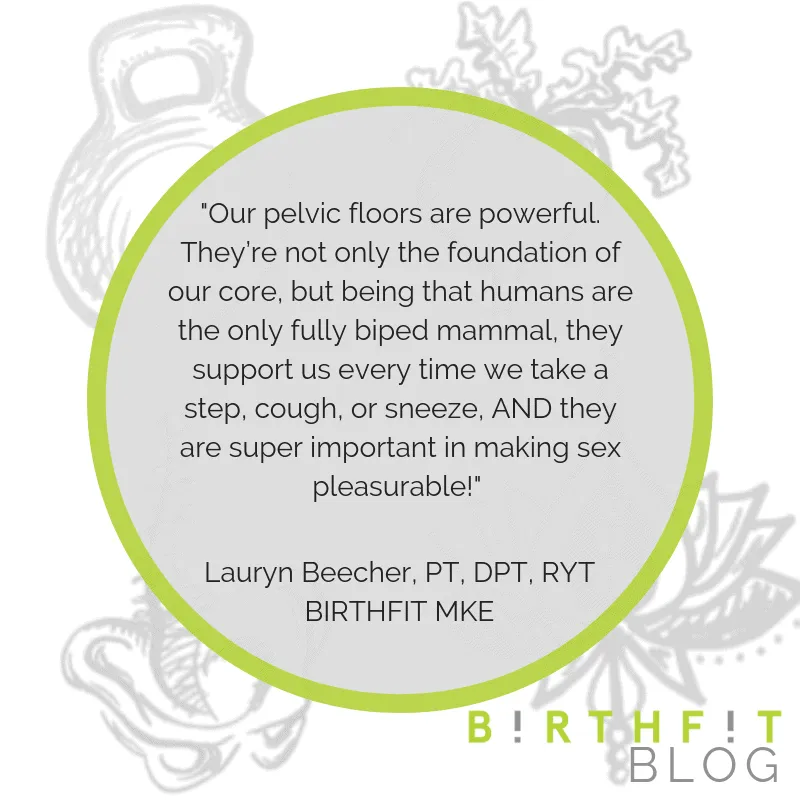Our pelvic floors are powerful.
They’re not only the foundation of our core, but being that humans are the only fully biped mammal, they support us every time we take a step, cough, or sneeze, AND they are super important in making sex pleasurable!
Here are the “Top Five Tips to Prepare your Pelvic Floor for Birth.”
1. Connect: When was the last time you paid attention to your pelvic floor; really paid attention? We want to be good and comfortable LONG before there’s a baby pushing against it.
- First off, how aware are you of your pelvic floor just sitting here? Can you feel any tension down there? Can you feel your pelvic floor lengthen a little as you inhale? Return as you exhale? If you’re struggling, you’re not alone. Aren’t you glad you’re working on this now?
- Go ahead and lay back in your bed and prop yourself up with some pillows. Pull out a hand mirror (or front facing camera) and take a look. Does your pelvic floor move as you breath? Can you see your perineum descend and ascend with each breath in and out? Try placing your hand on your vulva. Can you feel movement? Try to kegel or squeeze and lift your pelvic floor muscles. Try to lengthen or bulge away. Still not feeling anything? Cough or laugh, that will get your pelvic floor moving for sure! Laying down not working? Try placing a foot on a step stool or sitting on the toilet.
- If using a mirror or placing your hand is outside of your comfort zone or reach (hello baby bump), try sitting on a stability ball, foam roller, yoga block, pool noodle, or even a rolled up towel. Sometimes this added bit of pressure can help you become a bit more aware!
2. Learn to Lengthen: So now you’ve connected. The next step is learning how to lengthen your pelvic floor. Since I’m guessing you’ve pooped before, trust me, you’ve already done this.
- Set yourself up in a nice comfortable position. Maybe laying on your back with a pillow under your knees. Maybe you prop yourself up in Supta Baddha Konasana, supported bound angle pose. Wherever you are, relax. Let go of any tension. Now check your mouth and jaw. If you’re clenching your jaw, chances are there is still some tension in your pelvic floor. Now let go. Take a full breath in through your nose. Gently exhale through your mouth. Can you feel your pelvic floor lengthen on your inhale and can you keep it relaxed as you exhale?
- It can help to visualize a circle expanding, a flower blooming, even an elevator lowering.
- Still having a tough time? Try humming or speaking at a low pitch. Remember how the tension in your jaw is a good indicator of tension at your pelvic floor? The reverse is true too!
- Ready to take it up a notch? Try the same breathing, visualization, and voice activities in a Happy Baby or Child’s pose, or even a low or supported squat.
- Still having a tough time? Reach out to a Pelvic Floor Physical Therapist for some hands on help!
3. Perineal Massage: Perineal massage is an amazing tool to not only help you continue to connect with your pelvic floor, but start to become more accustomed to lengthening and stretching. You can do this on your own with your thumb(s) or your partner’s assistance to help further decrease the likelihood of perineal trauma in birth and perineal pain postpartum (1).
Check out this link for detailed instructions! (I would recommend using a high quality coconut or olive oil, aloe vera, or a lubricant such as Yes!, Slippery Stuff, Good Clean Love, or Sliquid Organic. Lubricants like KY Jelly and Astroglide can cause skin irritation and tissue damage to sensitive tissues.)
4. Birthing Positions: You don’t have to give birth on your back! Play around with different labor and delivery positions well before you go into labor. Figure out what feels right to you. Have your partner or whomever will be helping you give birth practice with you so they know how to support you. An upright delivery position such as squatting, kneeling, or being on hands-and-knees can not only help labor continue to progress, but also help reduce the risk of perineal trauma (i.e. perineal tearing). With upright positioning, we work with gravity, the pelvis widens, and there is a better oxygen supply to the baby because the person giving birth is not lying on their aorta, the body’s main blood vessel (2). When you are lying on your back, everything slows down and you have to push UPHILL. I don’t know about you, but pushing out a baby sounds like enough work without gravity working against me. Check out Evidence Based Birth for some helpful pictures and in depth descriptions and the science behind different labor and delivery positions!
5. What you do after giving birth to your baby is just as important as what you do before. The tips below can help your pelvic floor and perineum heal after a vaginal birth.
- Get your pad/mesh underwear ready and use a numbing spray before going to the bathroom
- Take your time going to the bathroom, no need to strain (this is a great time for stool softeners and prunes)
- Keep this area clean by using a peri bottle and air drying or gentle patting
- Ice will help reduce swelling, and help your pelvic floor feel better, sooner. Consider putting aloe vera, witch hazel, or essential oils like lavender, rosemary, and tea tree on pads and tossing them in the freezer to make your own “padsicles.”
- And of course Sitz baths – great for you and baby
BONUS TIP:
Remember that perineal stretching from before you delivered? If intercourse or pressure on your perineum is uncomfortable, gentle work on your scar tissue can help the area become more elastic again! This can be a great addition once you are “healed” and have the clearance to return to intercourse.
Lauryn Beecher, PT, DPT, RYT
Citations
- Beckmann, Michael M, and Owen M Stock. “Antenatal Perineal Massage for Reducing Perineal Trauma.” The Cochrane Database of Systematic Reviews, John Wiley & Sons, Ltd, 30 Apr. 2013, https://www.ncbi.nlm.nih.gov/pubmed/23633325.
- Gupta, Janesh K, et al. “Position in the Second Stage of Labour for Women without Epidural Anaesthesia.” The Cochrane Database of Systematic Reviews, John Wiley & Sons, Ltd, 25 May 2017, https://www.ncbi.nlm.nih.gov/pubmed/28539008.
Get Started
Effective programs for both MIND ⊕ BODY
This is a general strength and conditioning program for women in all seasons and cycles of life. You receive four workouts each week with options for those with limited equipment and variations on movements.
Start moving and training with your cycle ❤︎
Slow is Fast when you heal your core and pelvic floor from the inside out by starting with breath work, natural movement patterns, and continue to progressively build upon a solid foundation. The number one referral for doctors and midwives.
Are you open to conception? Join us in B! Community training. A general strength and conditioning for women that train while honoring their menstrual cycle. Everyone is in a different part of their journey, we support you where you are.
Do Pregnancy Different, when you connect with your body daily through a safe, effective prenatal training program for all levels and all fitness backgrounds that includes core and pelvic floor prehab, mobility, strength, and conditioning.





